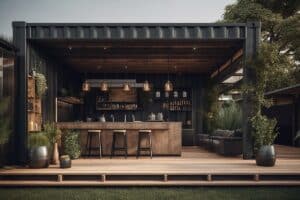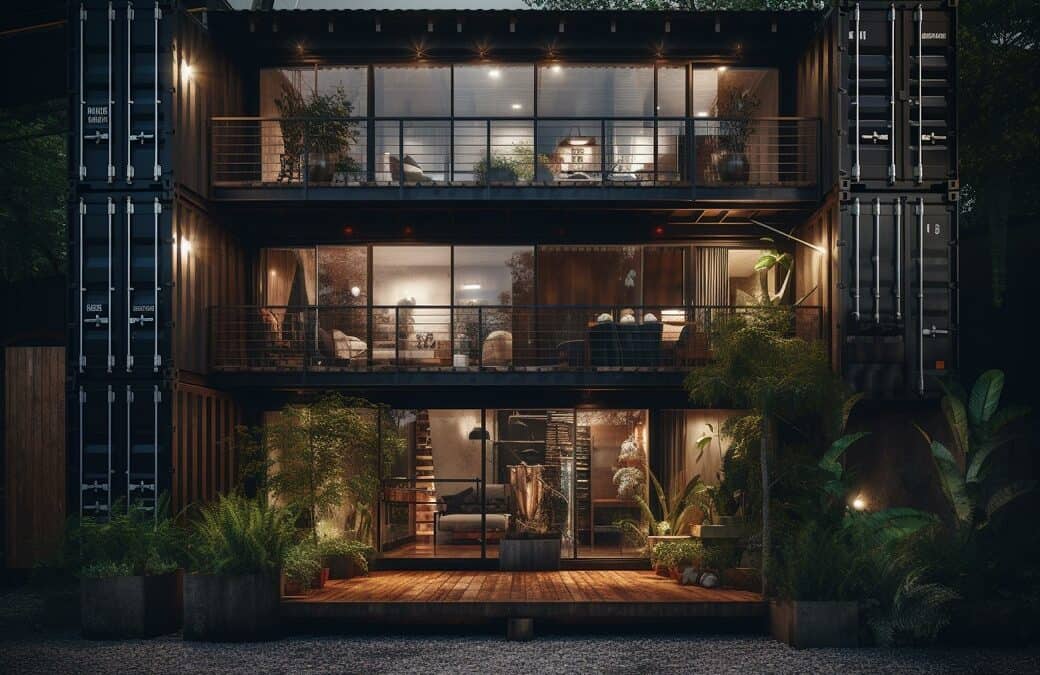These shipping containers are the workhorses of global trade. They come in a few sizes, with the 20-foot and 40-foot versions being the most common. What makes them so special? Well, they’re tough, weather-resistant, and built to be easily moved from ships to trucks to trains.
Now, imagine taking these sturdy boxes and creating a home out of them. Sounds kind of cool, right? Over the last couple of decades, a lot of imaginative folks have been doing just that. This trend, known as shipping container architecture, involves repurposing these containers into functional and often stylish living spaces. From cozy cabins to spacious family homes, these aren’t just boxes anymore—they’re innovative and sustainable solutions for housing.

Modern home design, backyard bar area made with shipping containers.
Creative Examples
The ingenuity and creativity in transforming shipping containers into living spaces are boundless. This section showcases an array of remarkable examples that span minimalist havens, luxurious abodes, hybrid designs, utilitarian constructions, and imaginative retreats.
- Minimalist Designs
With the rise in shipping container sales, there has been a simultaneous surge in interest in minimalist living. Minimalist designs in shipping container homes are the epitome of the confluence between simplicity and sustainability.
- Single-Container Homes
When space is at a premium, single-container homes come into their element. Crafted out of one 20-foot or 40-foot shipping container, these homes focus on the essentials. By using clever design tricks such as multifunctional furniture and maximizing natural light, they create a feeling of spaciousness in a compact area. These homes often have a contemporary flair, combining the industrial feel of the container with modern amenities.
- Micro-Living And Tiny Homes
Beyond single-container homes, micro-living takes minimalism to new heights. These tiny homes, often comprising less than 200 square feet, are built with a keen eye on utilizing every inch of space efficiently. Be it a pull-out bed, a rooftop deck, or a foldable kitchen table, the innovations in micro-living designs exemplify how to live large in a small space.
- Luxury And Upscale Designs
For those who think that shipping container homes are synonymous with modest living, luxury designs are here to change the perception.
- Multi-Container Mansions
With the stacking and juxtaposing of multiple shipping containers, it’s possible to build sprawling mansions that rival traditional homes in opulence. These constructions utilize multiple containers to create expansive living spaces, including multiple bedrooms, state-of-the-art kitchens, and even swimming pools. Ample windows and modern finishes erase any traces of the containers’ humble origins.
- Incorporating Glass And Open Spaces
A popular trend in luxury container homes is the incorporation of extensive glass features and open spaces. By replacing container walls with floor-to-ceiling windows or glass doors, these homes invite natural light in, seamlessly blending indoor and outdoor spaces. Terraces, balconies, and landscaped areas further add to the sense of spaciousness and luxury.
- Hybrid Designs
Hybrid designs represent the fusion of traditional building materials with shipping containers, resulting in unique and sustainable homes.
- Mixing Traditional Building Materials With Containers
Hybrid designs often include shipping containers as part of a larger structure, blending them with materials like wood, concrete, or brick. This fusion not only offers a distinctive aesthetic but also can enhance the insulating properties and overall comfort of the home.
- Incorporating Green Roofs And Renewable Energy
Another facet of hybrid designs is the incorporation of green roofs, which involve the cultivation of vegetation on the roof. This not only improves insulation but also creates an appealing natural space. Coupled with renewable energy sources such as solar panels, these homes can achieve a high level of sustainability and energy efficiency.
- Functional And Utility-Focused Designs
Not all shipping container architecture is focused on permanent homes; there’s a spectrum of functional and utility-focused designs too.
- Mobile Homes And Pop-Up Spaces
Shipping containers’ inherent portability makes them ideal for mobile homes and pop-up spaces. Whether it’s a mobile office, a traveling exhibition, or even a portable cafe, the possibilities are endless. With some ingenuity, these containers can be modified to be easily transported and set up in various locations.
- Disaster Relief And Emergency Housing
In the aftermath of natural disasters, shipping containers can be life savers. They can be quickly converted into emergency housing units, providing a secure and weather-resistant shelter. Furthermore, they can be used for mobile medical units or storage spaces for relief supplies.
- Unique And Unconventional Designs
The modularity and durability of shipping containers have given rise to an array of unique and unconventional designs.
- Artist Studios Or Retreats
For artists seeking a sanctuary to unleash their creativity, shipping containers offer an inspiring canvas. These spaces can be designed with large windows for natural light, outdoor areas for working in nature, and open interiors for versatile use.
- Treehouses And Elevated Structures
Elevating imagination—literally—some shipping container homes take to the trees. These elevated structures can be perched among branches, offering a unique living experience close to nature. By raising the containers on stilts, these homes can also be adapted to environments prone to flooding.
As this section reveals, shipping containers can be transformed into a diverse range of homes and spaces, from minimalist to luxurious, functional to unconventional. This adaptability highlights the endless possibilities in container architecture.
Conclusion
It’s clear that shipping container homes present an intriguing intersection of sustainability, creativity, and limitless possibilities. From an environmental standpoint, repurposing shipping containers is a remarkable way to give new life to what might otherwise be scrap metal.
When it comes to creativity, the options are truly endless. The modularity of shipping containers means they can be stacked, joined, and modified in an endless array of configurations. From minimalist abodes to luxurious estates, these versatile building blocks cater to a diverse range of tastes and needs.

Recent Comments